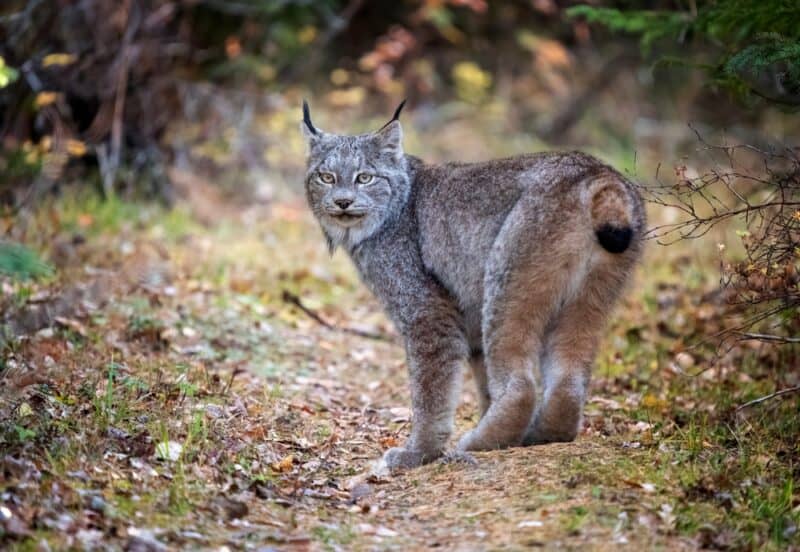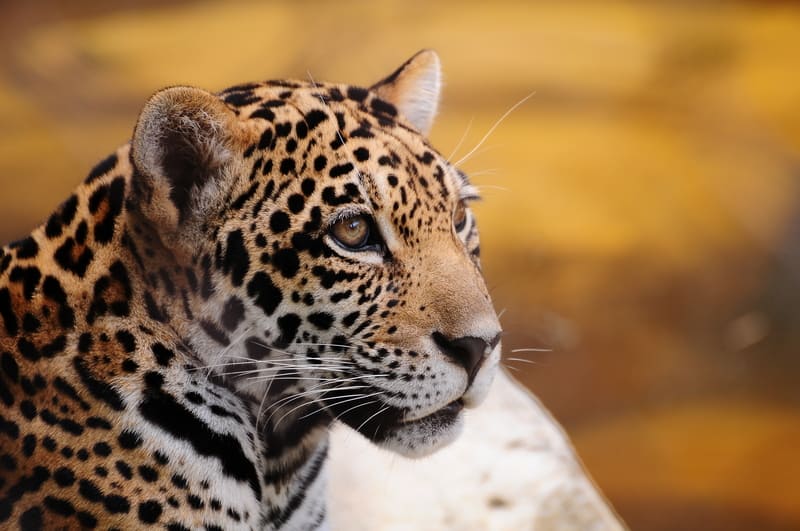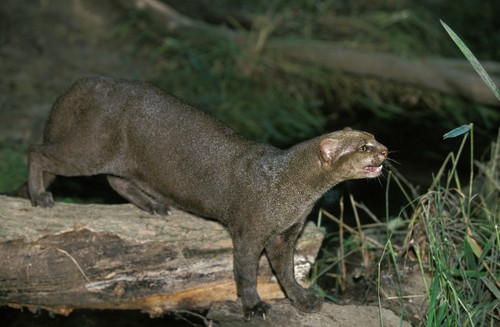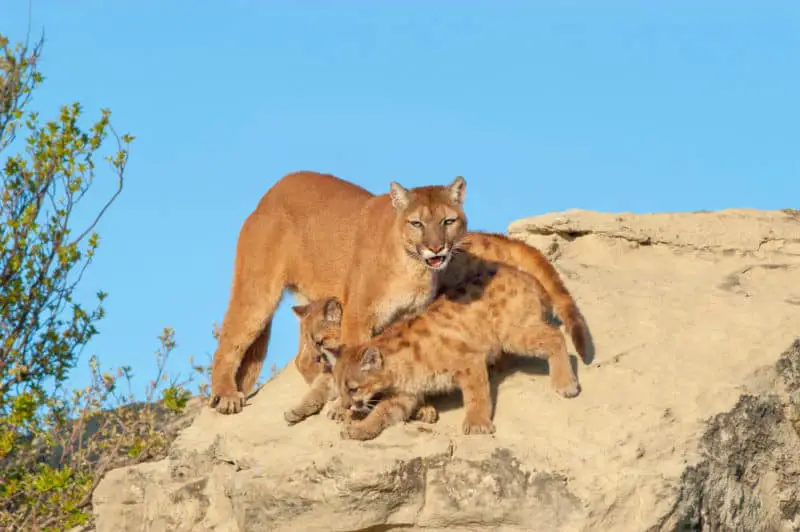New Mexico has 3 different species of wild cats. They are the mountain lion, the bobcat, and the Canada lynx. People also report sightings of Jaguars and Jaguarundis in the state. It’s not known, though, if these two cat species have breeding populations within New Mexico or if the cats that people are seeing are wandering individuals that have temporarily separated from their main populations in northern Mexico.
Mountain Lions in New Mexico (Puma Concolor)
Mountain lions range over a huge geographic area that covers parts of all 3 American continents. Consequently, they have quite a few different regional names. In 1834 their scientific name was even changed from Felis concolor to Puma concolor. Some common names that mountain lions go by are cougar, panther, Florida panther, painter, and puma.
What do mountain lions look like?
A Mountain lion looks like a giant house cat with short tan hair. One of these animals is much bigger than a domestic cat, though. They are a large apex predator. In New Mexico, they are only rivaled by the black bear. The other apex predator in New Mexico is the Mexican gray wolf.
They generally have lean, muscular bodies, rounded heads, and oval, upright ears. They also have a long tail, which is tan with a black tip. Their tail accounts for almost one-third of their entire length. Their long tails help them keep balance.
Mountain lions have a light brown coat of short, coarse hair over most of their body. The area around their nose, the tip of their tail, and the tips of their ears are black. Their belly, the area above their upper lip, lower lip, and chin are all white. They also have a sprinkling of dark hair across their backs. It’s also a fact that their coat color varies somewhat with geographic location.
Male and female mountain lions are phenotypically identical in every respect except for size. Males are 30 to 40% bigger than females. Though sizes vary considerably throughout the cat’s geographic range, an adult male or tom typically weighs between 110 and 180 pounds, 50 to (82 kgs). A rare few of them grow bigger than 200 pounds (91kgs). Female mountain lions or queens average between 80 and 130 pounds (36 to 59 kgs). Adult males or toms will reach 6 to 8 feet (1.8 to 2.4 M) from their snout to the tip of their tail. On the other hand, adult females are 5 to 7 feet long (1.5 to 2.1 M).
Mountain lions are the fourth largest wildcat in the world. They are also the second largest cat in the Western Hemisphere. They are smaller in size only than the Jaguar in the Americas. However, worldwide, the African Lion and the Tiger are also larger.
A fun fact is that despite their large size, they are not taxonomically classified as big cats because they cannot roar. Leopards, for example, are smaller than mountain lions, but since they can roar and cannot purr, they are classified as big cats, while mountain lions are not. Another interesting thing that I can mention here is that mountain lions purr.
Since they purr and cannot roar, mountain lions are in the Felis genus. Meanwhile, big cats, such as the African lion, tigers, leopards, snow leopards, and jaguars which cannot purr and can roar, are in the Panthera genus. “A side note, I listed snow leopards separately from leopards because they are a separate species.”
Where are they typically found?
Mountain lions live on all three American Continents. Their range begins in the Yukon territory of Canada in the north and extends down through parts of North America, Central America, and South America to southern Argentina.
The biggest mountain lion populations in Canada are in British Columbia and Alberta. In the United States, they mainly live in the western states and Florida.
In New Mexico, mountain lions have historically inhabited all areas of the state except for the plains on the eastern side of the state. They prefer areas of pinyon/juniper, ponderosa, mountain mahogany/oak brush, or even sub-alpine meadows. The deciding factor in habitat selection is the abundance or lack of deer. Deer are, hands down, the wildlife species they prefer to prey on.
Mountain lions are solitary animals the majority of the time. They get together to mate, and of course, the female keeps her young with her until they can strike out on their own. Otherwise, they’re loners.
They cover a lot of country. Home ranges for adult male mountain lions are normally more than 100 square miles and up to 250 square miles. They sometimes mark their territory by leaving claw marks on trees. They also scratch up piles of leaves and or pine needles that they urinate on as scent markers. Male mountain lions fight to the death sometimes to defend their territory.
What do mountain lions eat?
Mountain lions are opportunistic predators that hunt mostly nocturnally, stalking their prey, mainly deer, from behind. In New Mexico, this could be a mule deer, a coues white-tailed deer, or a Texas white-tailed deer.
On average, a mountain lion kills a deer once a week. Additionally, they consume elk, desert bighorn sheep, pronghorns, feral horses, coyotes, raccoons, birds, rats, feral pigs, javelina, porcupines, skunks, snakes, and small pets, domestic livestock, and literally any other native wildlife they can catch. In areas where there are moose, mountain lions prey on them. I didn’t add moose to the mountain lion’s prey list here because although they occasionally wander into the state from southern Colorado, they are very rare in New Mexico.
Do mountain lions ever harm humans?
I’ve taken much of the following section from another one of my blog posts entitled “Are Mountain Lions Dangerous?” Found here.
Fatal mountain lion attacks on humans are extremely rare. In fact, there are only 20 records of fatal mountain lion attacks on humans in all of North America in the last 100 years. Don’t let that fact lull you into a complete sense of false security, though. There have been many more mountain lion attacks over the years that didn’t result in a fatality. Mountain lions are, in fact, dangerous.
A mountain lion is a formidably tough wild predatory animal. They can run 40 to 50 miles per hour for short bursts. Additionally, they can leap 18 feet vertically and 40 feet horizontally to catch their prey. These ninja-like predators typically stalk their prey from behind and then leap on an animal’s back. They then crush their cervical spine or larynx with their powerful jaws. They have a bite force of 750 pounds per square inch.
Some factors that cause mountain lions to attack humans
The majority of the time, mountain lions use their ghost-like skills to avoid human contact. On rare occasions, though, they attack humans. Below are a few of the reasons why.
- If the cougar has an injury or some sort of impairment that prevents it from killing its normal prey, it’ll be more likely to look at a person as potential prey.
- Male mountain lions engage in fights for territory. Some of their battles are to the death. A percentage of cougar attacks on humans are perpetrated by hungry semi-juvenile toms that have been kicked out of territories with a more abundant food supply.
- Scientific data suggests that mountain lions that were orphaned at a young age are more likely to attack humans. This is possibly because they missed the part of their training where their mothers taught them that humans are to be feared.
I don’t intend to scare the reader from being outdoors. Mountain lion attacks on humans are extremely rare. The drive you take to get into mountain lion country is statistically much more dangerous than being there is. However, you shouldn’t be so naive as to think that bad things never happen. Here is an occurrence that recently happened in Utah.
Click on the “Are Mountain Lions Dangerous?” link at the beginning of this section for more information on this subject.

Bobcats in New Mexico (Felis rufus)
The US Fish and Wildlife Service estimates that bobcat numbers are somewhere between 700,000 and 1,500,000. They are the most common wild cat in The United States.
Bobcats live only in North America. Their range begins in southern Canada, about where the range of their close relative, the Canada lynx, begins to dwindle out and extends south into southern Mexico.
According to the New Mexico Department of Game and Fish, bobcat populations are in every county in the state. They live in a wide variety of habitats that vary from the sandy deserts of the Sonoran zone to high mountainous alpine regions. See
What do bobcats look like?
A bobcat is much smaller than a mountain lion and slightly smaller than a Canada lynx. In fact, smaller female bobcats are not much bigger than large domestic cats.
A bobcat is 2 to 3 feet long and weighs about 15 to 35 pounds. A Female bobcat is quite a bit smaller than a male.
These animals have a “bobbed,” short tail with black bands on their upper surface. Their tail also has a black tip on its upper surface but not the back. Their fur is usually gray to brown, with mottled dark spots that range from black to dark brown on their bodies. They also have black bars on their inner forelegs and tail.
From a side view, you will notice that a bobcat is slightly higher at the rump than at the shoulders. Bobcats and lynx have long hind legs in proportion to their forelegs.
Bobcats have black-tufted ears. In other words, they have tufts of hair that poke up above their ears and are black at the tips. The backs of their ears, below the black tips, are white. In the center of the white of each ear, they have a single black spot. This gives the impression of a false eye on the back of each ear.
They also have a whiskered face that seems broader due to their long ruffled facial hair and whiskers. Their eyes are yellow with round black pupils.
What do bobcats eat?
Despite their comparatively small size, bobcats are aggressive, tough predators. At times, particularly during the winter, they prey on animals that are much larger than they are, such as deer. However, their regular diets mainly consist of small prey such as small mammals, reptiles, birds, and carrion. When they take up residence close to a residential area, their menu might occasionally also include small pets.
Interestingly, they even prey on rattlesnakes even though they are not immune to rattlesnake venom. They accomplish this by using their quickness to pin the snake’s head down with a paw, after which they dispatch the snake with a quick bite to its spine behind the head.

Canada Lynx in New Mexico (lynx canadensis)
The Canada Lynx is sometimes also known as the Canadian Lynx. They are 1 of 2 North American members of the “Lynx” genus. The other one is the bobcat.
They are medium-sized wild cats that live in the boreal forest in the mountainous regions of Canada, the northern United States, and the southern Rockies.
Canada Lynx is a historic resident of New Mexico. However, any Canada lynx that are currently in New Mexico have likely wandered into the state from southern Colorado, or they are descendants of Colorado lynx that have arrived since the lynx recovery project was initiated in that state in 1999.
Habitat loss is the greatest threat to lynx populations in the lower 48 states. The U.S. Fish and Wildlife Service listed Canada lynx in the contiguous United States as threatened under the Endangered Species Act. However, in Southern Colorado and Northern New Mexico, those protections extend only to the animals and not their habitat.
Other U.S. states that have Canada lynx are Alaska, Colorado, Washington, Idaho, Montana, Minnesota, Wisconsin, Vermont, Michigan, New Hampshire, and Maine.
Canada Lynx Characteristics
What does a Canadian lynx look like? Canadian Lynx closely resemble bobcats. However, there are some differences between the two. First of all, lynx are slightly larger than bobcats. They are up to 35 1/2 inches (90 cm) long and 26 inches (65 cm) tall. Additionally, they weigh up to 37 and a half pounds (17 kg).
Canadian Lynx have triangular pointed ears with black backs and long tufts of black hair on the tips. The hair tufts are much longer than a bobcat’s. They also have drooping flared facial ruff of white hair on the sides of their face beneath their chin.
Their eyes are green with round black pupils.
Lynx have long legs in proportion to their bodies, with their hind legs being slightly longer than their front ones. This gives their body a peculiar, downhill-sloped appearance.
Canadian Lynx have almost comical-looking oversized fur-covered paws. There’s a good reason for this. Their large paws function like snowshoes, allowing them to travel and hunt on top of the snow. Canadian lynx feet can keep almost twice as much weight from sinking into the snow as those of a bobcat. This is why they range over the deeper snow country of northern Canada while bobcats do not.
Canada Lynx have long, thick grey fur in the winter. By summertime, they have shed their grey fur and have a thinner, shorter reddish tan hair coat instead. Their color is more uniform than that of bobcats. While bobcats have black spots and mottled coloration over their entire body, Lynx are solid tan except for some mottled darker brown spots on their legs.
What do Canada Lynx eat?
Mice, squirrels, ptarmigan, grouse, ducks, deer, Dall sheep, and caribou make up a minor portion of a Canadian lynx’s diet in regions where these prey animals are available. However, they have adapted to mainly prey on snowshoe hares.
Lynx and Snowshoe Hare
The Canada lynx is very dependent on snowshoe hares as a food source. In some areas, hares comprise 75% of their total diet. In fact, their population density is directly correlated with the snowshoe hare population.
Canadian and Alaskan Canadian Lynx and snowshoe hares go through what is known as the Lynx-Snowshoe Hare Cycle. When food sources are abundant for hares, their population increases very rapidly since they can have several litters per year. When hare populations are at their peak, there can be as many as 1500 animals per square kilometer ( 3913 per square mile). At this time, the population of Lynx and other predators are also at their peaks.

Jaguars in New Mexico (Panthera onca)
Jaguars are the largest cats in the Americas and the third largest wild cat in the world. Only the tiger and the African lion are larger than the jaguar. They are stout, muscular cats with legs that are short in proportion to their body size. Their legs are also short in comparison to other similarly sized big cats.
According to Wikipedia, they range from 68 to 75 cm (26.8 to 29.5 in) in shoulder height. Their body length from the tip of the nose to the rump varies from 1.12 to 1.85 m (3 ft 8 in. to 6 ft 1 in). Additionally, their weight ranges from 56–96 kg (123–212 lb). Males are usually 10 to 20% larger than females.
In appearance, a jaguar resembles a leopard with thicker, stouter features. The color of their hair coat along their back and sides ranges from light tan to light orange, overlaid with black spots. There are also extremely rare melanistic jaguars that are completely black. People sometimes mistakenly call these black panthers.
What do Jaguars eat?
Jaguars are apex predators and, thus, opportunistic feeders that feed on a variety of prey. Monkeys, capybaras, tapiras, and caimans are just a small sample of the animals on their menu in South and Central America. They even use their tails to lure in fish to catch. In Mexico, their diet overlaps with that of the mountain lion in that a large percentage of their diet consists of deer meat.
In New Mexico, a jaguar’s diet is going to be similar to that of one in Sonora Chihuahua. They will eat deer, pronghorns, javelina, and smaller prey such as reptiles, rabbits, and packrats.
Where do jaguars live?
The range of the jaguar extends into all three American continents, from Argentina in the south to the U.S./Mexico border country in the north.
Before European settlement in what is now the United States, the Jaguar’s former range stretched across southern Texas, New Mexico, Arizona, southern California, and as far north as the South Platte River in Colorado.
Since 1996 seven jaguars have been sighted in the United States. These were all either in southern Arizona or southwestern New Mexico. All 7 of the jaguars sighted were males. This leads biologists to believe that these males are looking to expand into new territory north of the main breeding population in Mexico.
The desert southwest of the U.S. is the extreme northern boundary of their territory. Between the years 1540 through 1996, there were only 20 reported jaguar sightings in New Mexico.

Jaguarundi in New Mexico (Herpailurus yaguarondi)
Jaguarundis are small wild cats that are native to the three American continents. They are roughly twice the size of a domestic cat. These animals also look similar to large domestic cats with some minor distinctions. They have an elongated body with proportionately short legs. Additionally, they have a narrow head with small, wide-set ears. This gives them the slight appearance of a mustelid rather than a feline.
Adult jaguarundis stand around 14 inches (35.56 cm) at the shoulder and weigh 6.6 to 15 pounds (3 to 6.80 kg)
Jaguarundis have two color morphs. They are either grey or reddish brown.
Jaguarundis live from Argentina north through South and Central America and Mexico up to the desert southwest of the United States, in Texas, New Mexico, and Arizona.
As with Jaguars, the borderlands between the United States and Mexico are the extreme northern boundary of the Jaguarundi’s range.
Although these cats are occasionally sighted and identified in New Mexico, they are extremely rare within the state, and any breeding populations of them may only reside as far north as northern Mexico.
Also See
Wild Cats In Arizona – Krebs Creek
Wild Cats of Texas – Krebs Creek
Recent Posts
The only venomous snakes in Washington State are Northern Pacific Rattlesnakes. The Northern Pacific Rattlesnake (Crotalus oreganus oreganus) is a sub-species of the Western Rattlesnake. Anyone...
Skunks are not classified as true hibernators. But they go into a state of torpor when the weather gets cold. Skunks are light sleep hibernators, along with opossums, bears, and raccoons. ...

